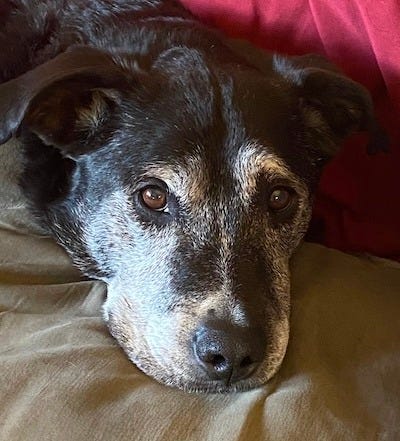It’s mid-morning, and Beau, our goofy German Wirehair, is pacing in front of my walk-in closet, where I am dressing, anticipating (pressuring me) for our morning walk. His big brown eyes are focused on my every move, and when I reach for my walking shoes, he jumps joyfully. Never mind that it is the same routine, the same road we walk most days of the year. He runs down the long dirt driveway, looks both ways for vehicles on our isolated graveled road (yes, he really does that), and crosses over to the small grove of Ponderosa pines to smell the night’s animal traffic. Ryder, our sweet older half-pit bull, seldom joins us, spending his days resting and lying next to my partner, Guy.
We adopted eight-year-old Beau from a local dog rescue when he was about two. A family who could not afford the parvo treatments surrendered him to a vet. Ryder lived with Guy’s aunt and uncle until his uncle died and his aunt moved to a care center. I don’t think he has recovered from that dramatic change. He lives with separation anxiety, following Guy's every move.
Our third “dog” is actually a cat. Stache the Cat is the boss in the house and employs multiple tactics to sustain domination over his canine and human housemates. We brought him home as a semi-feral kitten, and like most cat caregivers, we have become his servants. The dogs fear him, and he takes full advantage of his ability to intimidate them: sleeping in their dog beds, drinking from their water bowl, blocking them from leaving or entering a room, and play-attacking them outside. If the dogs rush him at the door, they get swatted, claws out. Wagging tails accidentally hit Stache in the face? Swatted, claws out. The canines sleep with one eye open when the cat prowls about, seemingly looking for a bit of trouble.
Our pets have a considerable influence on our daily activities. Like me, Beau is an early riser who enthusiastically greets me in the dark. His message is clear: Aren’t you thrilled to be alive another day? Any attempt to sleep in a bit is thwarted by Stache, who jumps on the bed and nuzzles his furry head into mine. He prefers my flower bed over his litter box and needs me to open the door. Ryder likes to sleep in and waits for Guy to rise to eat. Ryder is my work companion in the garden, inspecting every inch for new scents and then settling in to supervise my activity. He occasionally demands that I throw a stick for him to retrieve. Beau gets bored in the garden, seeking more lively outdoor adventures. Guy and I talk a lot about our pets, sharing what we have observed daily. They offer us glimpses of animal wisdom - we only have to pay attention.
The Pet Effect
Researchers have studied “the pet effect” on humans, and for most people, having a pet benefits both our mental and physical wellness. Multiple studies have focused on the impacts of pets on older people:
Companionship, reducing loneliness
Can increase social interaction with people via dog walks
May lower blood pressure and reduce stress
Encourages exercise (walking dogs)
Decreases symptoms of depression
Can improve cognition
Aging with pets can also have its challenges. Pets can contribute to falling accidents and become too much to handle when walking on a leash. Once, Max and Murphy, two beloved dogs before Beau and Ryder, pulled me into a snowbank as they chased a squirrel. Fortunately, I suffered only a bit of embarrassment. The cost of caring for pets rises as they age, and some pet owners may forgo health care because of limited finances.
One of the more painful challenges of aging with pets is the possibility of dying without a plan for our companions. In the US, over 6 million pets are admitted annually to animal shelters, and 10% are surrendered because of an owner’s death or incapacity. Many of these pets are older and less likely to be adopted. Unfortunately, most older people do not have a plan for their pets if they die first.
During the last ten years of her life, my mom fostered stray dogs waiting to be adopted. She was a loving but failed foster, adopting two Chihuahuas, Buddy and Leia, and almost adopting a third. When my mother returned home from the hospital under hospice care, Buddy and Leia jumped up onto her hospital bed, greeting her with licks. Returning home to her “babies” was the happiest moment of her declining condition.
When she died two months later, Buddy and Leia were confused and distraught. When my stepfather left two months later to live with one of his daughters, he had to leave them behind with my sister. None of this had been planned, and my sister already had numerous cats and didn’t want the cost and responsibility of two aging dogs. I lived 1300 miles away and already had three pets. Buddy and Leia were depressed and unhappy, and our attempts to list them for adoption were not successful. Fortunately, a year later, my mom’s vet found a couple who adopted both. Within a week, Buddy and Leia returned to their old selves, delighted to be sitting in laps and going for walks.
Planning for Pets
As pet caregivers, part of our end-of-life planning and paperwork should include a plan for our pets. Some things to consider:
Don’t assume a family member or friend wants to adopt your pets. Ask without pressure and observe how they interact with your pets. Have honest discussions with potential caretakers.
If someone agrees to adopt your pet, make a formal agreement. And create a backup plan in case of changes.
Pets can be expensive to own, so setting up a fund for their future care can help a caretaker take on the responsibility of pet ownership.
This past year, I learned about two elders in my small community looking for someone to adopt their pets because they each had only a few months to live. They had no family or friends to care for their companions and wanted to ensure their pets were adopted by loving people. This tugged at my heart for weeks—such an unselfish but heart-wrenching act of love for their pets.
The ASPCA offers a thorough guide and information on creating a plan for your companions.
I’ll end with a poem by Mary Oliver, dog lover & poet.
A Bad Day
Ricky, why are you barking and trying
to rip up the couch? Can’t you settle
down? It’s been a long day.
“It sure has. First you forgot to take
me out. Then you went to the market
and heaven knows where else. And my
dinner was late. And our walk was
short. And now you’re supposed to
be on the floor playing with me but,
no, you’re doing something else. So I
thought I’d give this couch a little
distress.”
Well, don’t. Be a good boy.
“Honestly, what do you expect? Like
you I’m not perfect, I’m only human.”
-Mary Oliver, in “Dog Songs”
Thank you for being here. If you’d like to support my work, you can do so by:
Liking this post so that others are encouraged to read it
Leaving a comment
Sharing this post via email or on social media
Taking out a paid subscription to this Substack
Share your experiences or offer more advice on aging with our pets.









Thank you for another important thing to consider. Our pets are a huge, important part of our lives and deserve to be cared for if we no longer can. My husband and I are in the process of writing up our will, and our horses, dog and cat are included therein. It is heartbreaking when a pet, especially an older one, is left by their owner. They do not understand why they no longer see their person, and hopefully they will end up in a home lovingly cared for, just as Buddy and Leia did.
I love your description of Stache ruling Beau, Ryder, and the household. So cat!
On another note, I was excited and happy to be able to recommend The Village to a friend of my Mom's, in her 80's, who has no family and is concerned how she will get along as she ages farther. Thank you!
Love this, thanks! I have a twofold plan. Sunny's breeder will always take back a pup she bred, no questions asked. Presumably, since she has four or five dogs, she would find a home for her. But I also have money in my will for a friend (who is unable to adopt her) to use for her care, and she takes responsibility to make sure Sunny finds the right home. It was such a comfort last year when I thought these might be needed -- all parties stood ready to help however they could. The thing I hadn't done was write up notes on her care, medications, personality, etc., which was a project by itself!